| |
- 'The Drawings of Frank Lloyd Wright' von Arthur Drexler, veröffentlicht von Bramhall House, New York 1962
Abb. _01 FLWF 5825.005 Schaubild der lebendigen Stadt 'The Living City' 1958, Ausschnitt
Abb. _19 5825.002 Darstellung der lebendigen Stadt, Ausschnitt, veröffentlicht in 'The Living City' 1958 [Seite 181] http://www.archive.org/
Abb. _20 FLWF 5825.006 Schaubild der lebendigen Stadt 'The Living City' 1958, Ausschnitt
Abb. _21 FLWF 5825.007 Schaubild der lebendigen Stadt 'The Living City' 1958, Ausschnitt
[Zuweisung der Nummern nach unterschiedlichen Quellen]
- 'The architecture of Frank Lloyd Wright' von Neil Levine, veröffentlicht bei Princeton University Press, 1996 http://books.google.com/
- 'Frank Lloyd Wright' von Bruno Zevi, veröffentlicht von Zanichelli Editore Bologna, 1994 [Erstveröffentlichung 1979] http://books.google.com/
Abb. _09 'Broadacre City' Modell 1934 - 35, Frank Lloyd Wright "Ansicht eines Reliefmodells von oben" [Seite 144]
Abb. _14 'Broadacre City' Modell 1934 - 35, Frank Lloyd Wright
oben: "Bereich D: einer der Märkte" [Seite 143]
unten beide: "Wohnhausmodelle. Haus für zwei Autos, Haus für drei Autos" [Seite 145] http://www.psu.edu/ […]
- 'Wunschmaschine Welterfindung. Eine Geschichte der Technikvisionen seit dem 18. Jahrhundert' Katalog zur gleichnamigen Ausstellung in der Kunsthalle Wien, Herausgeber: Brigitte Felderer, Springer-Verlag - 1996 http://books.google.com/
Abb. _18 'Clean Air Park' [veröffentlicht in 'This Week', 21. Juni 1959, Wasserfarben und Tinte] von Fred Freeman
www.fabiofeminofantascience.org http://dreamsofspace.blogspot.co.at/
- 'Yesterday's Tomorrows: Past Visions of the American Future' von Joseph J. Corn und Brian Horrigan, herausgegeben von Katherine Chambers, veröffentlicht von The Johns Hopkins University Press, Baltimore - 1996 [Erstveröffentlicht - 1984, bei Smithsonian Institution, New York] http://books.google.com/
11 Arthur C. Clarke (Koautor von '2001: Odyssee im Weltraum' 1968) [Seite V]
Abb. _13 [Seite 71] 'Crystal House' - 1934, George Fred Keck
für 'A Century of Progress Exposition' in Chicago 1933 - 34
Zum Vergleich: 'House of Tomorrow' 1933 (ebenfalls von Keck für die selbe Ausstellung) "View through hangar door showing airplane in place. […]"
Abb. _15 (Seite 45) 'Democracity' - 1939, New York World's Fair
» Created by industrial designer Henry Dreyfuss, Democracity [set in 2039] was essentially an updated version of ideas set forth at the turn of the century by British social thinker Ebenezer Howard [who] called for the decentralization of population and industry by the creation of garden cities. […] Democracity featured an urban core with tall, widely spaced buildings; separation of pedestrian and vehicular traffic; carefully delineated industrial and residential zones; and a generous greenbelt of farms and parks. « [Siehe dazu die Gartenstadt Eigendefinition von 1919]
http://morrischia.com/ [404]
http://davidszondy.com/
http://www.worldsfaircommunity.org/ 2
http://www.dailymotion.com/ [Edward Bernays] 2
https://youtu.be/
Abb. _16 [Seite 100] 'Personal Helicopter' von Alex S. Tremulis, 1944
Abb. _17 [Seite 107] 'Moonport' von Jim Powers aus der Reihe 'Life in the Year 2000', für Ford Motor Company, 1956
www.fabiofeminofantascience.org
10 (vgl. Seite 48-49) Die Weltausstellung von 1939 in New York mit dem Leitthema 'Building The World of Tomorrow' zeigte neben 'Democracity' unter dem Titel 'Highways and Horizons' [Futurama I], auch einen Gegenentwurf (?) für das Jahr 1960 als Vision von General Motors, gestaltet von Norman Bel Geddes.
http://xroads.virginia.edu/ (QuickTime Movie in voller Länge)
http://www.archive.org/ (unterschiedliche Formate)
http://youtu.be/
http://columbia.edu/ (Bilder)
http://fabiofeminofantascience.org/ (Bilder)
Auf dieser Weltausstellung von wurde auch 'The City' - ein Dokumentarfilm von Willard van Dyke und Ralph Steiner - gezeigt. Teil 1 und 2 bei http://youtu.be/
- 'Frank Lloyd Wright' ein Film von Ken Burns und Lynn Novick, The American Lives Film Project, Inc. - 1997, Teil 2 [Erstausstahlung 1998] http://www.pbs.org/ [Teil I Teil II bei http://youtu.be/ und auf spanish]
5 Vincent Scully: » It's not a civilised situation, its a heroic one. «
Abb. _03 Frank Lloyd Wright (Iowa County Messe, 1. September 1933, Filmaufnahmen von Alden B. Dow)
Abb. _05 Abb. _06 Abb. _07 Taliesin Fellowship [… gegründet 1932] (Filmaufnahmen von Alden B. Dow 1933, [wieder online: http://www.youtube.com/, Teil 2]
Abb. _08 Frank Lloyd Wright und seine 3. Ehefrau Olgivanna mit Gästen in Taliesin [Foto von Hedrich-Blessing 1938, Ausschnitt]
Abb. _10 'Usonia House for Mildred and Stanley Rosenbaum' 1939, Foto von G.E. Kidder Smith […]
Abb. _11 'House for Mr. and Mrs. H. A. Jacobs' 1936 […]
- 'Urban Utopias in the Twentieth Century: Ebenezer Howard, Frank Lloyd Wright, and Le Corbusier' von Robert Fishman, veröffentlicht von Basic Books, New York 1977
http://books.google.at/
12 Kapitel 15 'Prophetic Leadership' » The mark of the true artist-leader was his 'vision'. The forces of technological change were blind; the spirit of a nation inarticulate. The artist, Wright believed, could visualize force and spirit in a plan that would be both truly democratic and truly powerful. The plan was democratic not because it had been debated in a legislature or approved in an election but because it was representative of the nation's deepest feelings as understood by the artist. The plan was powerful because it embodied these feelings and merged them with the current of technological change. All art makes conscious the dreams of the artist's society. […] « [Seite 144] Übertragung aus dem Englischen von mir.
Abb. _04 'Contemporary City' Plan von Le Corbusier - 1922 [zwischen den Seiten 114 und 115]
Abb. _12 'Broadacre City' Modell 1934 - 35, Frank Lloyd Wright
Oben: "Typical home for sloping ground" [Zum Vergleich 'Gregor Affleck House' 1940 …]
Unten: "The circus for county fairs and pageantry, behind which stands a 'monumental pole' for announcing festivities."
Rechts: "High-rise apartments for 'the city-dweller as yet unlearned where ground is concerned.' " [Zum Vergleich 'St. Mark's Towers in the Bouwerie' 1929 …]
Alle drei Bilder erschienen in 'Architectural Record' 1935 [Fishman, zwischen den Seiten 114 und 115]
- 'USONIA - Frank Lloyd Wright's Vision for America' animiert von Studenten der Columbia University Graduate School of Architecture, Planning, & Preservation, Digital Design Lab, New York - 1997 (Britschgi, Hsu, Schafer, Strang …)
Abb. _02
- 'Die Großstadt ist nicht mehr modern. Broadacre City von Frank Lloyd Wright' von Peter Zellner, erschienen in DAIDALOS 69/70 1998, Berlin […]
8 (Seite 74) Laut Peter Zellner bereits 1935. [Deutsch, ohne Quellenangabe, nahezu identisch mit:
» Everywhere now human voice and vision are annihilating distance - penetrating walls. Wherever the citizen goes (even as he goes) he has information,
lodging and entertainment. He may now be within easy reach of
general or immediate distribution of everything he needs to have or to
know: All that he may require as he lives becomes not only more worthy of
him and his freedom but convenient to him now wherever he may choose to
make his home. «
aus: 'The Living City' von Frank Lloyd Wright, veröffentlicht von Horizon Press, 1958, Seite 122 - 125] http://www.archive.org/
9 (vgl. Seite 74) Peter Zellner sieht den typischen Bewohner Broadacres paradox, zwischen Nomaden- und verkabeltem Weltbürgertum angesiedelt.
- Zum Vergleich:
'Frank Lloyd Wright's Usonian Houses: Designs for Moderate Cost One-Family Homes' von John Sergeant, veröffentlicht von Watson-Guptill Publications / New York, 1984 Taschenbuchausgabe (Erstveröffentlichung 1976 in New York, von Whitney Library of Design) http://books.google.at/
und weiters:
'Frank Lloyd Wright: die Lebendige Stadt' herausgegeben von David G. De Long, veröffentlicht von Vitra Design Museum, Weil am Rhein / Skira editore, Mailand, 1998
http://books.google.at/
6 Wright bezieht sich dabei auf ökonomische Theorien von: Henry George und Silvio Gesell;
und laut John Sergeant werden ihm eine Reihe von Einflüssen zugeschrieben. Diese reichen von: Ralph Borsodi, Edward Bellamy, Peter Kropotkin, Ebenezer Howard, William Morris, H. G. Wells, … über Thomas Jefferson, Ralph Waldo Emerson, Henry David Thoreau, Walt Whitman … bis Jean-Jacques Rousseau, Charles Fourier, Pierre Joseph Proudhon … (aber nicht Karl Marx, wie Wright 1943 betonte)
[Friedrich Wilhelm Raiffeisen möchte ich noch anfügen]
Ungeachtet ihrer Popularität in den 30igern vermisst/vermeidet die zeitgenössische Rezeption tief greifende sozioökonomische Diskurse. Diese Analyse (nicht ausgenommen) deutet Broadacre als markanten Übergang des Utopischen, von einem 'selbstverständlich' sozialen Entwurf, zu einem 'selbstverständlich' technologischen Projekt. Siehe ebenfalls: XVIII.) 17
- 7 a Seit unserer [eigenen] Finanzkrise 2008 [1929] gelten Mikrofinanzierung, Komplementärwährungen und Tauschhandel [wieder] als mögliche Lösungsansätze. Mithin sind skeptische Untertöne, was die ökonomischen Ziele von Broadacre angeht, unangemessen.
http://youtu.be/
http://youtu.be/ [Wahrnehmung und Stimmung ähnlich wie in den 1930igern]
- 'Philip Johnson: life and work' von Franz Schulze, veröffentlicht von University of Chicago Press, 1996 http://books.google.at/
1 [Seite 222]
» Late in life, he [Philip Johnson] claimed that this famous slighting identification of Wright […] had been conceived in a retaliatory frame of mind and passed around his circle of New York friends as early as 1932 or 1933. «
2 Dieses Eingeständnis bezieht sich auf eine berühmte Auseinandersetzung zwischen Philip Johnson (+Henry-Russell Hitchcock) und Frank Lloyd Wright im Vorfeld der Ausstellung 'Modern Architecture: International Exhibition' von 1932 im Museum of Modern Art - New York, die Johnson als erster Direktor der Abteilung für Architektur am MoMA vorbereitet hat.
3 Die einflussreiche Publikation 'The International Style: Architecture Since 1922', die Philip Johnson and Henry-Russell Hitchcock im Kontext dieser Ausstellung zusammenstellten, prägte den Begriff 'Internationaler Stil' und machte die Arbeiten moderner europäischer Architekten wie Le Corbusier und Ludwig Mies van der Rohe einem amerikanischen Publikum deutlich.
15 » Between the time he [Frank Loyd Wight] was invited to participate and the the formal opening of the show, he threatened over and over to remove himself from it, agreeing to stay only when the curators persuaded 'Shelter' [magazine] to publish his essay "Of Thee I Sing". There, he visited more of his contempt on the International Style and its 'Geist der Kleinlichkeit' […], which he equated with "senility in the guise of invention". [… But Frank Lloyd Wright's] article had been published "with objectionable editorial comment under an objectionable pirated photograph of the damaged model of the House on the Mesa taken from an objectionable angle that best serves your objectionable propaganda." [Frank Lloyd Wright in einem Brief an Philip Johnson] « [Seite 83]
Im Detail: http://books.google.at/ [Seite 82]
und ebenfalls bei: http://books.google.at/ [Seite 45]
Siehe dazu: 'Die sieben Krücken der modernen Architektur' von Philip Johnson, 1954
- 'ARCHITEKTUR THEORIE von der Renaissance bis zur Gegenwart', 2003 ('Das 20. Jahrhundert' von Gilbert Lupfer, Jürgen Paul, Paul Sigel) veröffentlicht vom Taschen Verlag (Seite 714-721)
4
Wright bezeichnete diese Ausstellung ['Modern Architecture: International Exhibition' im Museum of Modern Art - New York 1932] XII.) 2 trotz seiner eigenen Beteiligung als "Propaganda" XII.) 15 und drohte mit Rückzug seines Projektes 'House on the Mesa' von 1931 "für eine Familie mit fünf Autos" und 1445 m2 Wohnfläche XIV.) 13 [a b … c]. http://savewright.org/ 2
Zum Vergleich: http://books.google.at/ [Seite 45]
- 'Frank Lloyd Wright 1917-1942: The Complete Works' [Band 2] von Bruce Brooks Pfeiffer, veröffentlicht vom Taschen Verlag 2010
13 [Seite 207]
- 'The Essential Frank Lloyd Wright: Critical Writings on Architecture' herausgegeben von Bruce Brooks Pfeiffer, veröffentlicht bei Princeton University Press 2008 http://books.google.com/
'The Disappearing City' 1932
14 » The Broadacre City
We are concerned here in the consideration of the future city as a future for individuality in this organic sense: individuality being a fine integrity of the human race. Without such integrity there can be no real culture whatever we call civilization may be.
We are going to call this city for the individual the Broadacre City because it is based upon a minimum of an acre to the family.
« [Seite 242]
- 15 'The Mike Wallace Interview' mit Frank Lloyd Wright, aufgenommen am 1.9.1957 und am 28.9.1957 http://www.hrc.utexas.edu/ https://youtu.be/
Mike Wallace bezieht sich mit seiner Frage nach Wrights religiöser Überzeugung auf dessen damals erst kürzlich erschienenes Buch: ['A Testament' von Frank Lloyd Wright veröffentlicht von Horizon Press, New York - 1957 http://www.steinerag.com/]
Wallace: » I understand that you attend no church ? «
FLW: » I attend the greatest of all churches … «
Wallace: » Which is ? «
FLW: » … and I put a capital 'N' on Nature and call it my church … and that's my church. «
Wrights [umfassend diskutiertes] 'spezielles' Verständnis von 'Natur', dem 'Organischen' und dem 'Lebendigen' ['nature', 'organic', 'life'] mag sich dadurch erschließen. [Siehe auch http://youtu.be/]
Das 'Problem' [heutiger Rezeption] liegt in der massiven Bedeutungsverschiebung dieser Schlüsselbegriffe in Wrights Arbeit in den letzten 100 Jahren (will man Wrights [und Sullivans] Ideen auf Konzepte des 19. Jahrhunderts zurückführen …).
Trotz unserer ungebrochenen Referenz zur "Natur", ist es ein großer Sprung von '[der] lebendige[n] Stadt' [1958] zum '[.] Baum der Erkenntnis ' [Maturana, Varela, 1984]
Andererseits …
» Primarily the word NATURE means the principle at work in everything that lives and gives to Life its form and character. […] The word has nothing to do with realistic or realism, but refers to the essential Reality of all things - so far as we may perceive Reality. We cannot conceive Life, we do not know what it is, but we can perceive the Nature of its consequences and effects and so enter into creation with some intelligence. […] The word ["Organic"] applies to "living" structure - a structure or concept wherein features or parts are so organized in form and substance as to be, applied to purpose, integral. Everything that 'lives' is therefore organic. The inorganic - the "unorganized" cannot live. « XVII.) 16 [Man beachte: "the organization of the living" …]
- 'Modern Architecture: Being the Kahn Lectures for 1930'
von Frank Lloyd Wright [zuerst erschienen 1931] mit einer neuen Einführung von Neil Levine, veröffentlicht von Princeton University Press, 2008 http://books.google.at/
16 '2: Style in Industry' [Seite 27]
- 'Science and Magic – What Technology Can and Can't Fix' Vorlesung von John Gray an der Architectural Association School of Architecture London, 9. März 2010 https://youtu.be/ and http://www.aaschool.ac.uk/ [gefunden im September 2015]
17 a In ähnlichem Zusammenhang: [0:22:30 bis 0:37:10] https://www.youtube.com/
- 0 Broad Acre - bezeichnet eigentlich einen 'breiten Acker', was sowohl der ursprünglichen Bedeutung dieses Flächenmaßes als auch seiner tatsächlichen Ausdehnung entspricht. Um dem Pathos und der Intention Frank Lloyd Wrights gerecht zu werden, erschien mir die Vorstellung vom 'weiten Land' angemessener. […]
» Wir werden diese Stadt für den Einzelnen Broadacre City nennen, weil sie auf einer minimalen Landfläche von einem Acre [4046,856 m2] pro Familie beruht. « XV.) 14 [FLW in 'The Disappearing City' 1932, Übersetzung von mir]
Nach Stefanie Bremer wurde 'Broadacre City' 1950 von Jäger und
Kanitsch mit 'Weitland' übersetzt. ['Broadacre City und die Zwischenstadt' Seite 37, Fußnote 28, Duisburg-Essen, 2008 http://duepublico.uni-duisburg-essen.de/]
Dieser Begriff findet sich IN: 'DER SPIEGEL' 38/1952 ARCHITEKTUR / WRIGHT 'Der amerikanische Ausdruck' [s. Titel, Seiten 28 - 33] » … die Stadt "Weitland" … « [Seite 30] http://www.spiegel.de/
[siehe auch 'The Acres']
|
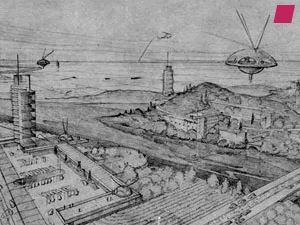
!['USONIA' - 1997, Computeranimation nach Motiven von Frank Lloyd Wright © Columbia University New York [Britschgi, Hsu, Schafer, Strang…] 'USONIA' - 1997, Computeranimation nach Motiven von Frank Lloyd Wright © Columbia University New York [Britschgi, Hsu, Schafer, Strang…]](content/columbia_university_1997_usonia.gif)
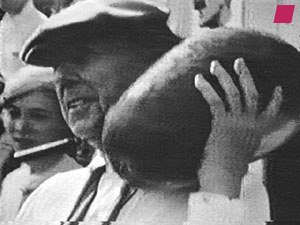
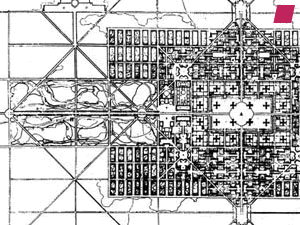


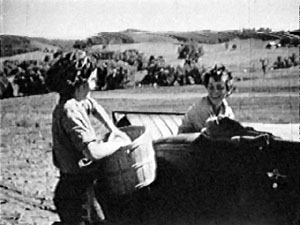
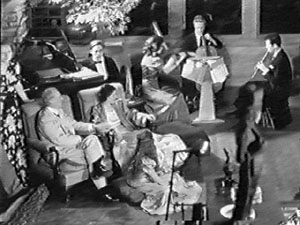
!['Broadacre City' Modell 1934 - 35, von Frank Lloyd Wright aus 'Frank Lloyd Wright' von Bruno Zevi, veröffentlicht bei Zanichelli Editore Bologna, 1994 [Erstveröffentlichung 1979] 'Broadacre City' Modell 1934 - 35, von Frank Lloyd Wright aus 'Frank Lloyd Wright' von Bruno Zevi, veröffentlicht bei Zanichelli Editore Bologna, 1994 [Erstveröffentlichung 1979]](content/frank_lloyd_wright_1934-35_broadacre_city_model.gif)

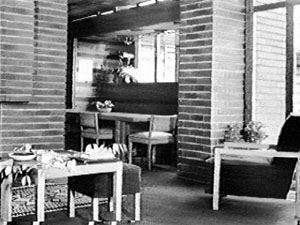

!['Crystal House' - 1934, von George Fred Keck aus 'Yesterday's Tomorrows: Past Visions of the American Future' von Joseph J. Corn und Brian Horrigan, herausgegeben von Katherine Chambers, veröffentlicht von The Johns Hopkins University Press, Baltimore - 1996 [Erstveröffentlicht - 1984, bei Smithsonian Institution, New York] 'Crystal House' - 1934, von George Fred Keck aus 'Yesterday's Tomorrows: Past Visions of the American Future' von Joseph J. Corn und Brian Horrigan, herausgegeben von Katherine Chambers, veröffentlicht von The Johns Hopkins University Press, Baltimore - 1996 [Erstveröffentlicht - 1984, bei Smithsonian Institution, New York]](content/george_fred_keck_1934_crystal_house.gif)
![Marktplatz, typische Häuser 'Broadacre City' Modell 1934 - 35, von Frank Lloyd Wright aus 'Frank Lloyd Wright' von Bruno Zevi, veröffentlicht bei Zanichelli Editore Bologna, 1994 [Erstveröffentlichung 1979] Marktplatz, typische Häuser 'Broadacre City' Modell 1934 - 35, von Frank Lloyd Wright aus 'Frank Lloyd Wright' von Bruno Zevi, veröffentlicht bei Zanichelli Editore Bologna, 1994 [Erstveröffentlichung 1979]](content/frank_lloyd_wright_1945_broadacre_city_modeldetail1.jpg)
!['Democracity' - 1939, von Henry Dreyfuss für die New York World's Fair aus 'Yesterday's Tomorrows: Past Visions of the American Future' von Joseph J. Corn und Brian Horrigan, herausgegeben von Katherine Chambers, veröffentlicht von The Johns Hopkins University Press, Baltimore - 1996 [Erstveröffentlicht - 1984, bei Smithsonian Institution, New York] 'Democracity' - 1939, von Henry Dreyfuss für die New York World's Fair aus 'Yesterday's Tomorrows: Past Visions of the American Future' von Joseph J. Corn und Brian Horrigan, herausgegeben von Katherine Chambers, veröffentlicht von The Johns Hopkins University Press, Baltimore - 1996 [Erstveröffentlicht - 1984, bei Smithsonian Institution, New York]](content/democracity_1939.jpg)
!['Personal Helicopter' - 1944, von Alex S. Tremulis aus 'Yesterday's Tomorrows: Past Visions of the American Future' von Joseph J. Corn und Brian Horrigan, herausgegeben von Katherine Chambers, veröffentlicht von The Johns Hopkins University Press, Baltimore - 1996 [Erstveröffentlicht - 1984, bei Smithsonian Institution, New York] 'Personal Helicopter' - 1944, von Alex S. Tremulis aus 'Yesterday's Tomorrows: Past Visions of the American Future' von Joseph J. Corn und Brian Horrigan, herausgegeben von Katherine Chambers, veröffentlicht von The Johns Hopkins University Press, Baltimore - 1996 [Erstveröffentlicht - 1984, bei Smithsonian Institution, New York]](content/alex_s_tremulis_1944_personal_helicopter.jpg)
!['Moonport' - 1956, von Jim Powers für die Ford Motor Company aus 'Yesterday's Tomorrows: Past Visions of the American Future' von Joseph J. Corn und Brian Horrigan, herausgegeben von Katherine Chambers, veröffentlicht von The Johns Hopkins University Press, Baltimore - 1996 [Erstveröffentlicht - 1984, bei Smithsonian Institution, New York] 'Moonport' - 1956, von Jim Powers für die Ford Motor Company aus 'Yesterday's Tomorrows: Past Visions of the American Future' von Joseph J. Corn und Brian Horrigan, herausgegeben von Katherine Chambers, veröffentlicht von The Johns Hopkins University Press, Baltimore - 1996 [Erstveröffentlicht - 1984, bei Smithsonian Institution, New York]](content/jim_powers_1956_moonport.jpg)
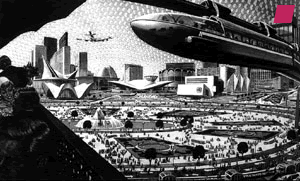
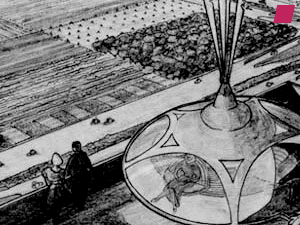
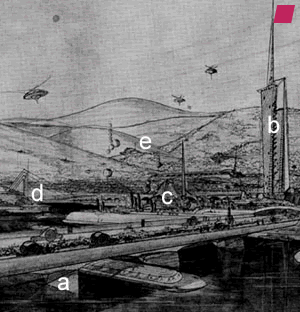
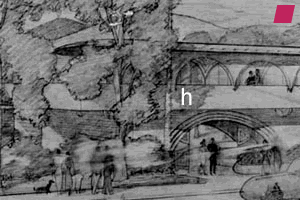






ZUM ANFANG
Soziale Netzwerke